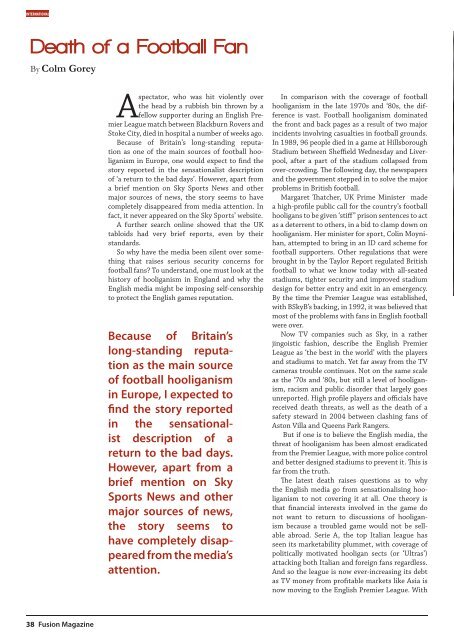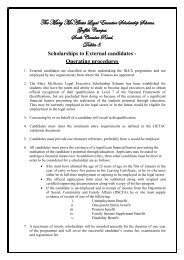Click here to View - Griffith College Dublin
Click here to View - Griffith College Dublin
Click here to View - Griffith College Dublin
- No tags were found...
Create successful ePaper yourself
Turn your PDF publications into a flip-book with our unique Google optimized e-Paper software.
internationalDeath of a Football FanBy Colm GoreyAspecta<strong>to</strong>r, who was hit violently overthe head by a rubbish bin thrown by afellow supporter during an English PremierLeague match between Blackburn Rovers andS<strong>to</strong>ke City, died in hospital a number of weeks ago.Because of Britain’s long-standing reputationas one of the main sources of football hooliganismin Europe, one would expect <strong>to</strong> find thes<strong>to</strong>ry reported in the sensationalist descriptionof ‘a return <strong>to</strong> the bad days’. However, apart froma brief mention on Sky Sports News and othermajor sources of news, the s<strong>to</strong>ry seems <strong>to</strong> havecompletely disappeared from media attention. Infact, it never appeared on the Sky Sports’ website.A further search online showed that the UKtabloids had very brief reports, even by theirstandards.So why have the media been silent over somethingthat raises serious security concerns forfootball fans? To understand, one must look at thehis<strong>to</strong>ry of hooliganism in England and why theEnglish media might be imposing self-censorship<strong>to</strong> protect the English games reputation.Because of Britain’slong-standing reputationas the main sourceof football hooliganismin Europe, I expected <strong>to</strong>find the s<strong>to</strong>ry reportedin the sensationalistdescription of areturn <strong>to</strong> the bad days.However, apart from abrief mention on SkySports News and othermajor sources of news,the s<strong>to</strong>ry seems <strong>to</strong>have completely disappearedfrom the media’sattention.In comparison with the coverage of footballhooliganism in the late 1970s and ‘80s, the differenceis vast. Football hooliganism dominatedthe front and back pages as a result of two majorincidents involving casualties in football grounds.In 1989, 96 people died in a game at HillsboroughStadium between Sheffield Wednesday and Liverpool,after a part of the stadium collapsed fromover-crowding. The following day, the newspapersand the government stepped in <strong>to</strong> solve the majorproblems in British football.Margaret Thatcher, UK Prime Minister madea high-profile public call for the country’s footballhooligans <strong>to</strong> be given ‘stiff” prison sentences <strong>to</strong> actas a deterrent <strong>to</strong> others, in a bid <strong>to</strong> clamp down onhooliganism. Her minister for sport, Colin Moynihan,attempted <strong>to</strong> bring in an ID card scheme forfootball supporters. Other regulations that werebrought in by the Taylor Report regulated Britishfootball <strong>to</strong> what we know <strong>to</strong>day with all-seatedstadiums, tighter security and improved stadiumdesign for better entry and exit in an emergency.By the time the Premier League was established,with BSkyB’s backing, in 1992, it was believed thatmost of the problems with fans in English footballwere over.Now TV companies such as Sky, in a ratherjingoistic fashion, describe the English PremierLeague as ‘the best in the world’ with the playersand stadiums <strong>to</strong> match. Yet far away from the TVcameras trouble continues. Not on the same scaleas the ‘70s and ‘80s, but still a level of hooliganism,racism and public disorder that largely goesunreported. High profile players and officials havereceived death threats, as well as the death of asafety steward in 2004 between clashing fans ofAs<strong>to</strong>n Villa and Queens Park Rangers.But if one is <strong>to</strong> believe the English media, thethreat of hooliganism has been almost eradicatedfrom the Premier League, with more police controland better designed stadiums <strong>to</strong> prevent it. This isfar from the truth.The latest death raises questions as <strong>to</strong> whythe English media go from sensationalising hooliganism<strong>to</strong> not covering it at all. One theory isthat financial interests involved in the game donot want <strong>to</strong> return <strong>to</strong> discussions of hooliganismbecause a troubled game would not be sellableabroad. Serie A, the <strong>to</strong>p Italian league hasseen its marketability plummet, with coverage ofpolitically motivated hooligan sects (or ‘Ultras’)attacking both Italian and foreign fans regardless.And so the league is now ever-increasing its debtas TV money from profitable markets like Asia isnow moving <strong>to</strong> the English Premier League. With38 Fusion Magazine
















